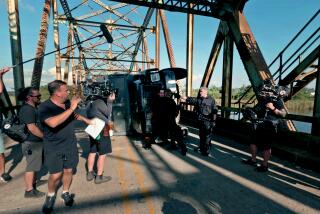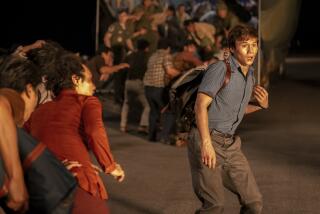‘The Hurt Locker’ sets off conflict
- Share via
Reporting from Baghdad, Los Angeles and Washington — Many film critics -- and awards voters -- have praised “The Hurt Locker’s” depiction of the U.S. military in Iraq, often singling out the bomb disposal drama for its authenticity. But as the film emerges as a favorite to win the best picture Oscar, a number of active soldiers and veterans say the film is Hollywood hokum, portraying soldiers as renegades while failing to represent details about combat accurately.
The criticism, coming just before Oscar ballots are due Tuesday, highlights the delicate relationship between “The Hurt Locker” and the nation’s armed forces. Defense Secretary Robert M. Gates says the film is “authentic” and “very compelling” and has recommended it to his staff. But the government says it pulled its “Hurt Locker” production assistance at the last minute in 2007, saying that the film’s makers were shooting scenes that weren’t in the screenplay submitted to the Defense Department, including a sequence that the government believed portrayed troops unflatteringly. The film’s producers dispute elements of the account.
Although “The Hurt Locker” has numerous supporters within the military -- including Purple Heart winner Drew Sloan, who participated in a “Hurt Locker” panel discussion in Hollywood with other veterans and the film’s makers Wednesday night -- the movie’s detractors share a consistent complaint about its representation of the Army’s Explosive Ordnance Disposal team as they attempt to disarm improvised explosive devices.
The film, directed by Kathryn Bigelow and written by journalist Mark Boal (who was embedded with a bomb disposal team), stars Jeremy Renner as Staff Sgt. William James. Not deterred by protocol or his own safety, James is an adrenaline-addicted bomb defuser who occasionally puts his unit at risk, and at one point takes to the streets of Baghdad on a solo personal mission. Members of EOD teams in southern Iraq said in interviews arranged by the Army that “The Hurt Locker” is a good action movie if you know nothing about defusing roadside bombs or the military.
Sgt. Eric Gordon of San Pedro, an Air Force EOD technician on his second tour in Iraq, has watched the movie a few times with his friends. “I would watch it with other EOD people, and we would laugh,” Gordon said.
He scoffed at a scene in which a bomb is defused with wire cutters. “It’s similar to having a firefighter go into a building with a squirt bottle,” Gordon said.
An EOD team leader in Maysan province, Staff Sgt. Jeremy D. Phillips, said, “My interest is bringing myself and my team members home alive, with all of our appendages in the right place.”
Although he was glad the film highlighted their trade, he disliked the celluloid treatment of EOD units. “There is too much John Wayne and cowboy stuff. It is very loosely based on actual events,” he said. “I’m honestly glad they are trying to convey to the public what we’ve been doing, and I wish maybe they had just done it with a little bit of a different spin on it,” he said.
Others are more supportive. Sloan, a former U.S. Army captain, said at the panel discussion that “The Hurt Locker” offered a perfect snapshot of modern conflict. “This is what’s going on for the men and women who are fighting this war,” he said.
Jim O’Neil, the executive director of the EOD Memorial, which honors those killed defusing bombs, was equally enthusiastic about the film’s accuracy. “It’s not just a movie,” he said at the panel discussion. “It’s something that’s actually occurring as we’re sitting in these chairs.”
Some recent veterans, however, disagreed. “The depiction of our community in this film is disrespectful,” said Paul Rieckhoff, the executive director and founder of the 150,000-member Iraq and Afghanistan Veterans of America. “We are not cowboys. We are not reckless. We are professionals. And a lot of the film would make you think the opposite.”
“I didn’t really care for it,” said Brian Siefkes, who served in Iraq and plays an Army soldier in the upcoming movie “The Green Zone.” “There were many moments where I felt they were trying to portray the actual life of EOD in Iraq but over-sensationalized it,” he said.
Boal, who also produced “The Hurt Locker,” said the film was not intended to be a documentary or a training film. “We certainly made creative choices for dramatic effect,” he said. “But I hope the choices were made respectfully and conscientiously.”
At one point, “The Hurt Locker” might have been made with government cooperation. But just 12 hours before Lt. Col. J. Todd Breasseale was to fly to Jordan to serve as the Army’s technical advisor to “The Hurt Locker,” he said in an interview that he heard there might be problems. A Jordanian official told him that scenes were being shot that were not in the script that the Army had approved. Breasseale accused the producer of shooting a scene in which soldiers act violently toward detainees. (The military does not provide help to films depicting violations of the laws of war, unless their consequences are shown.) He also charged that the production had driven a Humvee into a Palestinian refugee camp in order to film angry crowd scenes.
“Nice working with you,” Breasseale said he recalled telling a producer before the military decided to stop working with the production. “Kathryn has a lot of talent, but I cannot trust that your company will honor its contract to the soldiers and government of the U.S.” Breasseale said the filmmakers had been solicitous of the Army’s opinion, “trying to get the look and feel right,” and they had been allowed to film at an Army logistics base in Kuwait. Breasseale, who is now deployed, saw “The Hurt Locker” on a laptop in Afghanistan along with a soldier from one of the Army’s EOD teams. He conceded it was a great story and a “spectacular looking movie. But if you’re looking for realism and how military relationships really work, I believe she missed the mark,” Breasseale said of Bigelow.
Others in the Pentagon’s office overseeing work with Hollywood agree. “The filmmakers’ interest in drama and excitement exceeded what we felt were reasonable realistic portrayals,” said Philip M. Strub, the Pentagon’s special assistant for entertainment media.
Boal said that while the production initially worked with the U.S. military, it parted ways when it became clear they would not approve of “The Hurt Locker’s” script. He said the producers did not film on a base in Kuwait and never signed a contract.
“The Department of Defense did not support the movie. And my understanding is that they did not support ‘Platoon’ or ‘The Deer Hunter,’ ” Boal said of two of the most revered movies about the Vietnam War. “I am OK with that outcome because I didn’t want to change the script to suit them.”
The top Pentagon official, Gates, has a very positive view of the movie. “This is the first Iraq war movie that he has liked, or for that matter seen,” said Pentagon Press Secretary Geoff Morrell. “In looking at all previous films he thought they had too much of a political agenda.
“He just thought it was a very compelling, and what he thought was authentic, portrayal of what life is like for many of our troops in Iraq. Of the films that have been done about this war, that is the most authentic.”
More to Read
Only good movies
Get the Indie Focus newsletter, Mark Olsen's weekly guide to the world of cinema.
You may occasionally receive promotional content from the Los Angeles Times.











